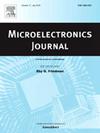Low-power 12T TFET-MOSFET hybrid SRAM bitcell and hybrid 8T SRAM array based on multiplexing strategy
IF 1.9
3区 工程技术
Q3 ENGINEERING, ELECTRICAL & ELECTRONIC
引用次数: 0
Abstract
Due to the limitation of MOSFET subthreshold swing, traditional MOSFET-based static random-access memory (SRAM) circuits are difficult to meet the design requirements of low-power integrated circuits. To address these issues, we proposed a half-select disturb-free 12T TFET-MOSFET hybrid SRAM bitcell. It can avoid the forward p-i-n current and effectively mitigate the effect of current degradation, which greatly reduces the static power consumption of the circuit and improves the performance of SRAM. Specifically, compared to 12T, the write delay of the hybrid bitcell decreased by approximately 13.994 % at 0.6 V. Meanwhile, a TFET-MOSFET hybrid 8T SRAM array is proposed by a multiplexing strategy to reduce the area consumption. The proposed hybrid SRAM array is comparable to the 12T bitcell in terms of static noise margin (SNM), read/write speed, and static power consumption. These results indicate that the proposed TFET-MOSFET hybrid 8T SRAM array is a good choice for applications that require low power consumption and high stability.
求助全文
约1分钟内获得全文
求助全文
来源期刊

Microelectronics Journal
工程技术-工程:电子与电气
CiteScore
4.00
自引率
27.30%
发文量
222
审稿时长
43 days
期刊介绍:
Published since 1969, the Microelectronics Journal is an international forum for the dissemination of research and applications of microelectronic systems, circuits, and emerging technologies. Papers published in the Microelectronics Journal have undergone peer review to ensure originality, relevance, and timeliness. The journal thus provides a worldwide, regular, and comprehensive update on microelectronic circuits and systems.
The Microelectronics Journal invites papers describing significant research and applications in all of the areas listed below. Comprehensive review/survey papers covering recent developments will also be considered. The Microelectronics Journal covers circuits and systems. This topic includes but is not limited to: Analog, digital, mixed, and RF circuits and related design methodologies; Logic, architectural, and system level synthesis; Testing, design for testability, built-in self-test; Area, power, and thermal analysis and design; Mixed-domain simulation and design; Embedded systems; Non-von Neumann computing and related technologies and circuits; Design and test of high complexity systems integration; SoC, NoC, SIP, and NIP design and test; 3-D integration design and analysis; Emerging device technologies and circuits, such as FinFETs, SETs, spintronics, SFQ, MTJ, etc.
Application aspects such as signal and image processing including circuits for cryptography, sensors, and actuators including sensor networks, reliability and quality issues, and economic models are also welcome.
 求助内容:
求助内容: 应助结果提醒方式:
应助结果提醒方式:


